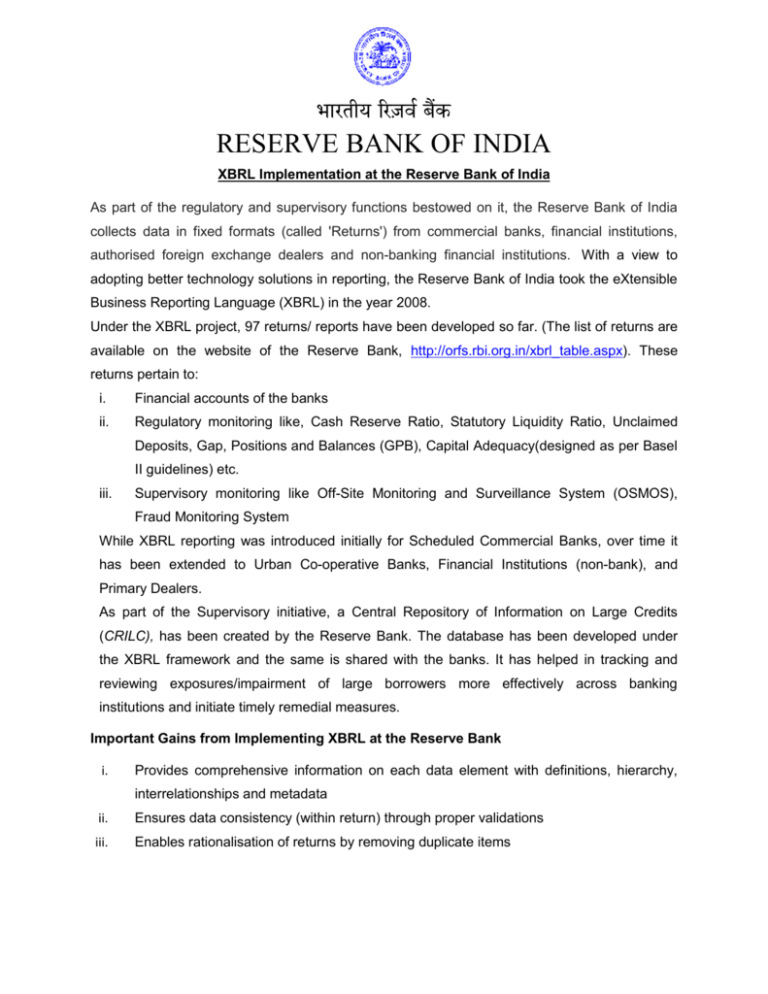भारतीय ररज़र्व बैंक RESERVE BANK OF INDIA
advertisement

भारतीय ररज़र्व बैंक RESERVE BANK OF INDIA XBRL Implementation at the Reserve Bank of India As part of the regulatory and supervisory functions bestowed on it, the Reserve Bank of India collects data in fixed formats (called 'Returns') from commercial banks, financial institutions, authorised foreign exchange dealers and non-banking financial institutions. With a view to adopting better technology solutions in reporting, the Reserve Bank of India took the eXtensible Business Reporting Language (XBRL) in the year 2008. Under the XBRL project, 97 returns/ reports have been developed so far. (The list of returns are available on the website of the Reserve Bank, http://orfs.rbi.org.in/xbrl_table.aspx). These returns pertain to: i. Financial accounts of the banks ii. Regulatory monitoring like, Cash Reserve Ratio, Statutory Liquidity Ratio, Unclaimed Deposits, Gap, Positions and Balances (GPB), Capital Adequacy(designed as per Basel II guidelines) etc. iii. Supervisory monitoring like Off-Site Monitoring and Surveillance System (OSMOS), Fraud Monitoring System While XBRL reporting was introduced initially for Scheduled Commercial Banks, over time it has been extended to Urban Co-operative Banks, Financial Institutions (non-bank), and Primary Dealers. As part of the Supervisory initiative, a Central Repository of Information on Large Credits (CRILC), has been created by the Reserve Bank. The database has been developed under the XBRL framework and the same is shared with the banks. It has helped in tracking and reviewing exposures/impairment of large borrowers more effectively across banking institutions and initiate timely remedial measures. Important Gains from Implementing XBRL at the Reserve Bank i. Provides comprehensive information on each data element with definitions, hierarchy, interrelationships and metadata ii. Ensures data consistency (within return) through proper validations iii. Enables rationalisation of returns by removing duplicate items XBRL Implementation at the Reserve Bank of India Challenges Faced during Implementation of XBRL at the Reserve Bank XBRL being a new technology, implementing the same was a challenge for both the Reserve Bank and the reporting entities. Important among them are: a. Building user awareness – numerous workshops including hands-on sessions were organised before and after the roll out. b. For ease of use, Excel templates are being provided for data entry, which is later converted into XBRL instance document. Complex validations are done off-line so that network resources are used optimally. c. Generation of user reports at the Reserve Bank based on the XBRL was found to be difficult especially for complex reports. Presently, XBRL data is moved to the Data Warehouse (DW) at the Reserve Bank and the reports are generated therefrom using Business Object tool. Way Forward Some of the steps being taken to improve the existing system at the Reserve Bank are: i. It is felt that the full potential of XBRL implementation will only be achieved once the banks are able to generate the XBRL instance document directly from the source system itself. However, for this, the banks need to integrate the multiple systems at their end first and then develop a tool for the automatic generation of XBRL instance documents. ii. As XBRL system identifies each data element through tags, the Reserve Bank is moving towards an element based reporting approach from the existing return based approach. iii. The Reserve Bank is aiming at using the XBRL platform for the reporting of all data by the regulated / supervised entities in due course. ***********






